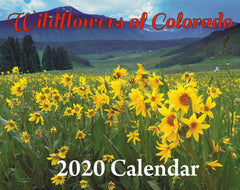Even though wildflowers are blooming about 2 weeks late in the high country of Colorado this year, it appears it’s going to be a great season for viewing the beauties. Recently Bernie and I went to Mount Evans and started our visit at the Dos Chapel Nature Center, that has an alpine flower garden built around it. We were amazed at the number of wildflowers beginning to bloom there. We met a volunteer who enthusiastically pointed out the Goldflower, Sky Pilot, Alpine Avens, Alpine Phlox and Snowball Saxifrage. We showed her our book, Rocky Mountain Wildflowers Field Guide that included all the flowers she had pointed out. She was impressed and bought the book on the spot and we of course signed it for her. She then suggested that we travel to the very top of Mt. Evans and look for the many patches of Forget-Me-Nots.

We took the winding road to the top joining a caravan on tourists to the top. Mountain goats along the way stopped the flow of cars with their antics. Even as we reached the top parking area, the goats were hopping around more or less oblivious to the visitors. A couple were even staying by the bathrooms as if waiting their turn. We walked down the trail behind the toilets in the direction of

the observatory. We soon spotted alpine flowers on the tundra. Many of the flowers were tiny, ¼ inch or less as our altitude was comparable to northern Canada’s tundra or to the Arctic Circle. Along the steep rocky trail, we spotted the following flowers that are all detailed in our new third edition 272-page book, Rocky Mountain Wildflowers Field Guide: Alpine-Forget-Me-Not, Alpine Sandwort, Moss Campion, Alpine Phlox, Fairy Primrose, Goldflower or Woolly Actinea, and Alpine Spring Beauty.
Many of these plants grow close to the ground where temperatures are at least 10 degrees warmer than at two to three feet higher. Some other plants form mats of tiny leaves resembling moss to hold in moisture. One should use extreme caution when hiking in the alpine tundra as some of these mats of plants may take up to 30 years to grow up to 3 feet across. Alpine Spring Beauty has a tap root that can extend ten feet or more to find nutrients and moisture for the plant.



As we returned down the road with our car, we went by a magnificent Bristlecone forest near the Nature Center. The upper section here has many twisted trees, standing for over fifteen hundred years even though some had been struck by lightning. Bristlecone Pines are the oldest living single organisms on earth. The trees are featured in our “South Park” coffee table books. Also check out our new 2020 Colorado Wildflower Photo Calendar now available through our website: www.highcountryartworks.com.


